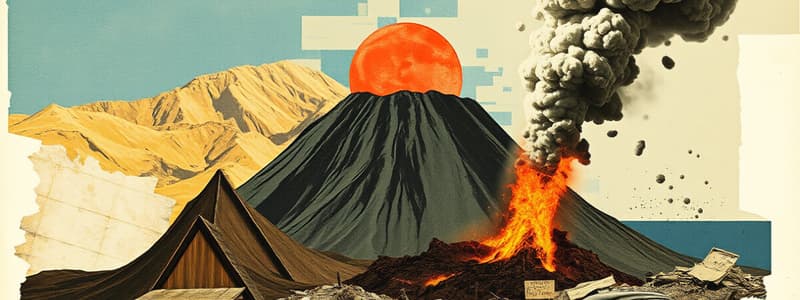Podcast
Questions and Answers
_____ are water waves generated by earthquakes, undersea volcanic eruptions, or landslides that hit bodies of water.
_____ are water waves generated by earthquakes, undersea volcanic eruptions, or landslides that hit bodies of water.
- Tidal waves
- Wind surges
- Tsunamis (correct)
- Wind waves
__________ is the disruptive up, down, and sideways vibration caused by passing seismic waves through the ground.
__________ is the disruptive up, down, and sideways vibration caused by passing seismic waves through the ground.
- Folding
- Ground subsidence
- Ground shaking (correct)
- Ground rupture
_____________ is the deformation on the ground that marks the intersection of the fault with the earth’s surface.
_____________ is the deformation on the ground that marks the intersection of the fault with the earth’s surface.
- Ground rupture (correct)
- Liquefaction
- Landslide
- Faulting
_______ is a phenomenon that occurs when loosely packed, water-logged sediments near the ground surface lose their strength in response to strong ground shaking.
_______ is a phenomenon that occurs when loosely packed, water-logged sediments near the ground surface lose their strength in response to strong ground shaking.
Earthquake-induced landslide is the down slope movement of rocks, soil, and other debris commonly triggered by intense _____________.
Earthquake-induced landslide is the down slope movement of rocks, soil, and other debris commonly triggered by intense _____________.
What are the two types of earthquakes?
What are the two types of earthquakes?
What is the point called where an earthquake starts inside the earth?
What is the point called where an earthquake starts inside the earth?
What is magnitude in relation to earthquakes?
What is magnitude in relation to earthquakes?
What are hazard maps?
What are hazard maps?
What is the primary driving factor of landslides?
What is the primary driving factor of landslides?
Flashcards
Tsunamis
Tsunamis
Water waves generated by earthquakes, volcanic eruptions, or landslides.
Ground shaking
Ground shaking
Disruptive vibrations caused by seismic waves.
Ground rupture
Ground rupture
Surface deformation where fault intersects Earth.
Liquefaction
Liquefaction
Signup and view all the flashcards
Earthquake-induced landslides
Earthquake-induced landslides
Signup and view all the flashcards
PHIVOLCS
PHIVOLCS
Signup and view all the flashcards
Tectonic earthquakes
Tectonic earthquakes
Signup and view all the flashcards
Earthquake magnitude
Earthquake magnitude
Signup and view all the flashcards
Earthquake intensity
Earthquake intensity
Signup and view all the flashcards
Seismic waves effects
Seismic waves effects
Signup and view all the flashcards
Earthquake Hazards
Earthquake Hazards
Signup and view all the flashcards
Hazard maps
Hazard maps
Signup and view all the flashcards
Landslide triggers
Landslide triggers
Signup and view all the flashcards
Volcanic landslides
Volcanic landslides
Signup and view all the flashcards
Study Notes
Earthquake Hazards
- Water waves generated by earthquakes, volcanic eruptions, or landslides are called tsunamis.
- Ground shaking refers to the disruptive vibrations caused by seismic waves passing through the ground.
- Ground rupture is the deformation on the surface where a fault intersects with the earth.
- Liquefaction occurs when loose, water-logged sediments lose strength due to strong ground shaking.
- Earthquake-induced landslides often occur with intense shaking, leading to the downhill movement of debris.
Philippine Institute of Volcanology and Seismology (PHIVOLCS)
- PHIVOLCS is a service agency under the Department of Science and Technology (DOST) focused on disaster mitigation from volcanic eruptions and earthquakes.
Types of Earthquakes
- Earthquakes are classified into tectonic and volcanic types, with tectonic earthquakes resulting from sudden movements along faults and plate boundaries.
Measuring Earthquake Strength
- Earthquake strength is measured using two metrics: magnitude and intensity.
- Magnitude indicates the energy released and is calculated using a seismograph, represented by Arabic numbers (e.g., 4.8, 9.0).
Effects of Geologic Layers on Ground Shaking
- Seismic waves have varying effects based on the geological materials they traverse, with solid bedrock resulting in high frequency and low amplitude shaking, and weaker materials causing higher amplitude and lower frequency vibrations.
Overview of Earthquake Hazards
- Earthquake hazards can lead to loss of life, injuries, property damage, economic disruptions, and environmental harm.
- Common hazards include ground shaking, ground rupture, liquefaction, landslides, and tsunamis.
Hazard Maps
- Hazard Maps visualize potential hazards in specific areas, identifying risks associated with earthquakes, liquefaction, and landslides.
- Ground shaking hazard maps display levels of shaking probability, while ground rupture hazard maps highlight fault lines.
Landslide Triggers
- Gravity is the primary driver of landslides, acting on sloped areas that lack stability.
- Landslide causes fall into two categories: natural and human-induced factors, with many instances arising from a combination of both.
Volcanic Activity as a Landslide Trigger
- Volcanoes, characterized by weak geological structures, are prone to collapse, leading to rockslides, landslides, and debris avalanches.
Studying That Suits You
Use AI to generate personalized quizzes and flashcards to suit your learning preferences.




